Hundred Board: 10 Ways to Learn Math With This Montessori Toy

I’ve said this before and I’ll say it again: the Montessori wood hundred board is an amazing math toy for kids. The hundred board has been one of our favorite ways to playfully learn math at home. It’s also a cornerstone math tool at their Montessori school.
Because hundreds boards are so versatile, I highly recommend them for preschoolers, kindergarteners, and early elementary students, whether or not you are homeschooling. Most kids learn core math skills at different ages. Even my children grasped certain concepts at different stages in their life. And I’ve seen many parents and teachers use hundreds boards well into third grade.
Tools for teaching math at home
- How I Taught My Daughter Basic Math For Free and Without Workbooks
- Interactive Calendar Learning Printables

Chalk Academy is reader-supported. Some of the links are affiliate links. When you buy something through an affiliate link, we may earn a very small commission at no cost to you. Details here.
Why we love the Montessori hundred board
When it comes to learning, nothing beats hands-on experiences. A strong math foundation begins with touching, feeling, and holding various items while observing, sorting, and evaluating their quantity, shape, and size.
Initially, I was not planning on buying a physical board since my daughter loves to use our printable hundred chart. But our wood hundreds board has been a worthwhile investment.
Four years ago, my daughter instantly loved the hundred board the moment we go it. She got so excited when she discovered new number patterns. And she even would start to time herself to see if she could finish it faster than the last time!
Eventually, she outgrew the board and it sat dusty and ignored for a couple years. Would little brother ever use it? Turns out, little brother just needed a little more time. A few months ago, he was ready for the hundred board!
The first several times, we did the board together, and I would help him lay out all of the coins and turn them upright. Initially, passing “9” was really challenging. For example, counting from 19 to 20, 29 to 30, 39 to 40, and so on was really tricky until he started noticing the patterns on the board.
For both of my children, I really loved seeing how focused and independent they could be without worrying about writing any numbers.
In addition to strengthening fine motor skills, my kids have enjoyed color patterning as well as counting and skip counting practice!
Which type of hundred board should I get?
There are 2 types of hundred boards: 100 square blocks or 100 round coins.
Square block hundred board
The original Montessori hundred board has squares with numbers printed in D’nealian font. This font is used in Montessori classrooms because:
- The “4” is open rather than closed, to distinguish it from 9
- The “9” has a straight rather than curved line, to distinguish it from 6
Where to buy
- Elite Montessori’s wood hundred board has high reviews.
- If you budget is more important to you than font, consider this popular and affordable option.
Round coin hundred board
Available in beautifully finished, dark walnut or light maple wood, we love Treasures from Jennifer’s hundred board. It comes with colorful wool balls or wood balls, but number coins are sold separately.
After we purchased her board that you see in these photos, Jennifer released a new board with flat (pegless) coins. Recently, I got a chance to compare our board with our friend’s newer version with the flat coins. I think the flat coins are more user friendly for young children because they don’t move around so much. Also, if you’re bilingual, you could put translations on the other side of the coin.
Where to buy
10+ ways to use the wooden Montessori hundred board
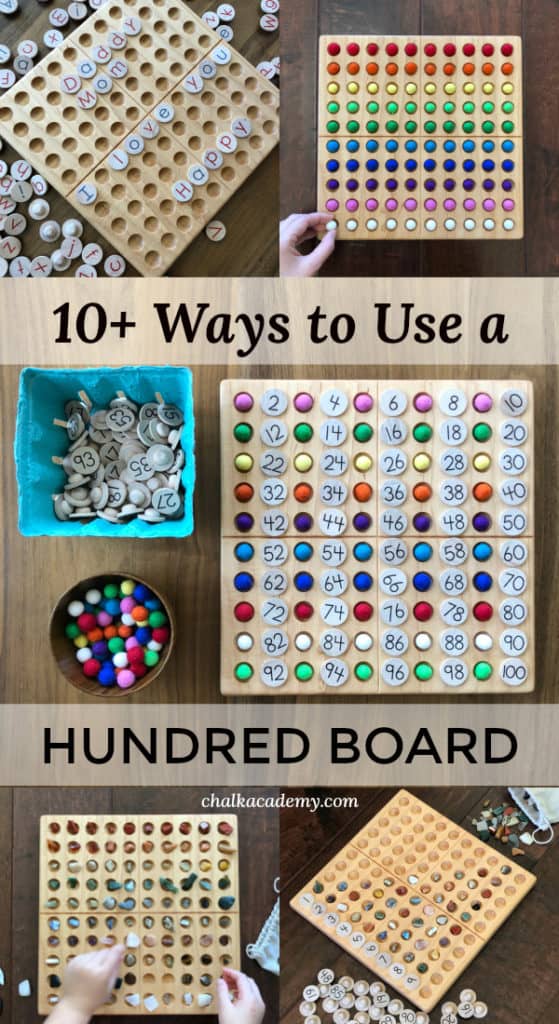
I’m excited to show you how my children have been using the Montessori hundred board for playful learning!
At first, a hundreds board can feel overwhelming for some kids. Working with the smaller numbers before moving on to the big numbers will make counting less intimidating. Once your child has mastered 1 through 10, move up to 11 through 20. Keep going until you’ve reached all the way to 100; then move on to the harder concepts.
Note: Due to risks of choking, small objects used with this board should be placed out of reach from babies, toddlers, and children who mouth objects.
Sort pompoms by color
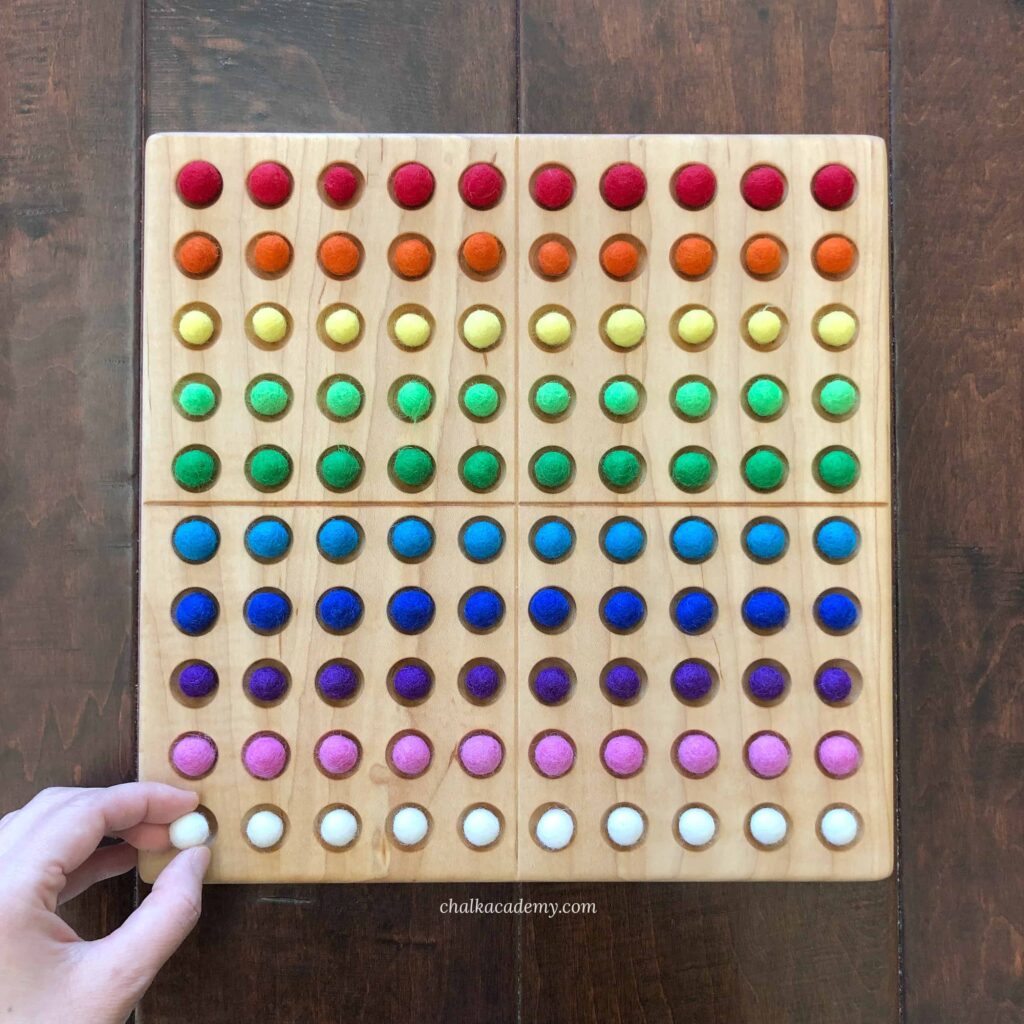
For your little ones who aren’t yet counting, try starting out with colors. Sorting the wool pom poms by color is an easy way to start using the board!
Count rocks, pom poms, and other small objects with a 100 board

We have had a lot of fun counting rocks and pom poms! While placing one object in a dimple, you can practice counting out loud slowly and carefully with your child.
The engraved lines divide the board into 4 quadrants and also separate each row into groups of 5. This will help a child “subitize” numbers, essentially the ability to eyeball a number of items quickly without counting each item individually.
After we counted our colorful crystals out loud, we sorted the colors by row into a rainbow! As you can see, the benefits include strengthening fine motor skills, learning patterns, visual discrimination, and creating art!
Starting off with verbal counting helps your child build a strong foundation. As well as 1:1 correspondence below, it must be mastered before your child can begin to learn some of the more abstract math concepts.
Learn 1:1 correspondence with a hundreds board
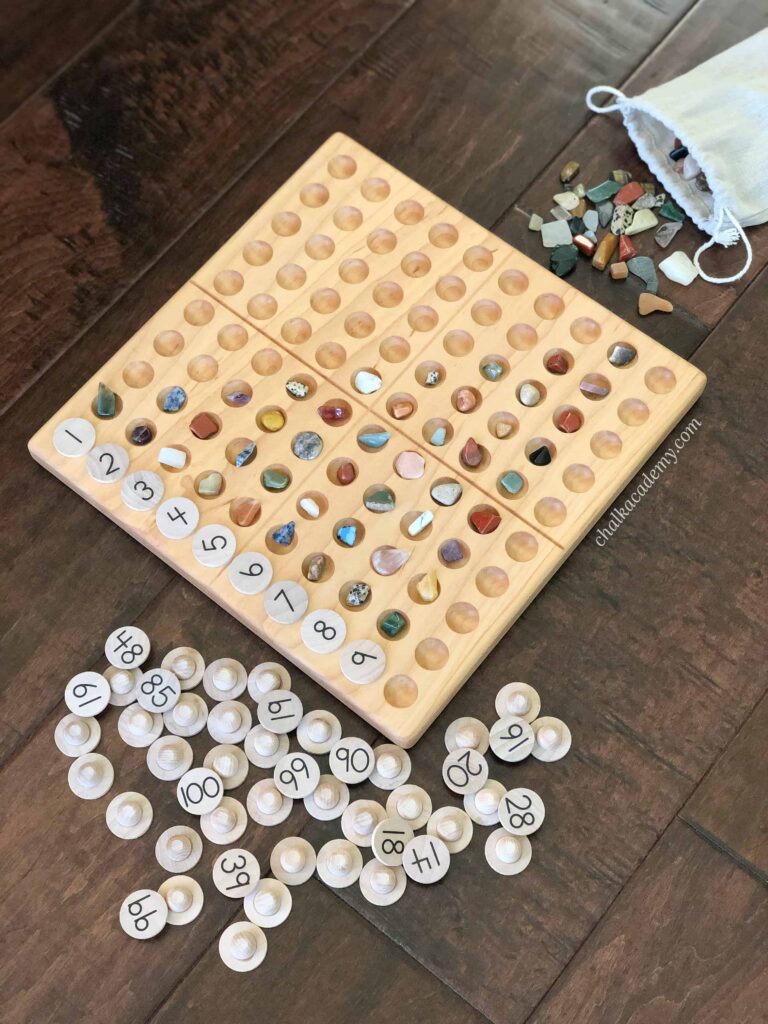
The little round dimples are perfect for teaching 1:1 correspondence. We placed one rock next to number 1, two rocks next to number 2, three rocks next to number 3, and so forth.
Tip: Teach the number symbol after the child understands the concept of rational counting rather than rote counting.
Arrange the numbers chronologically in a 100 board
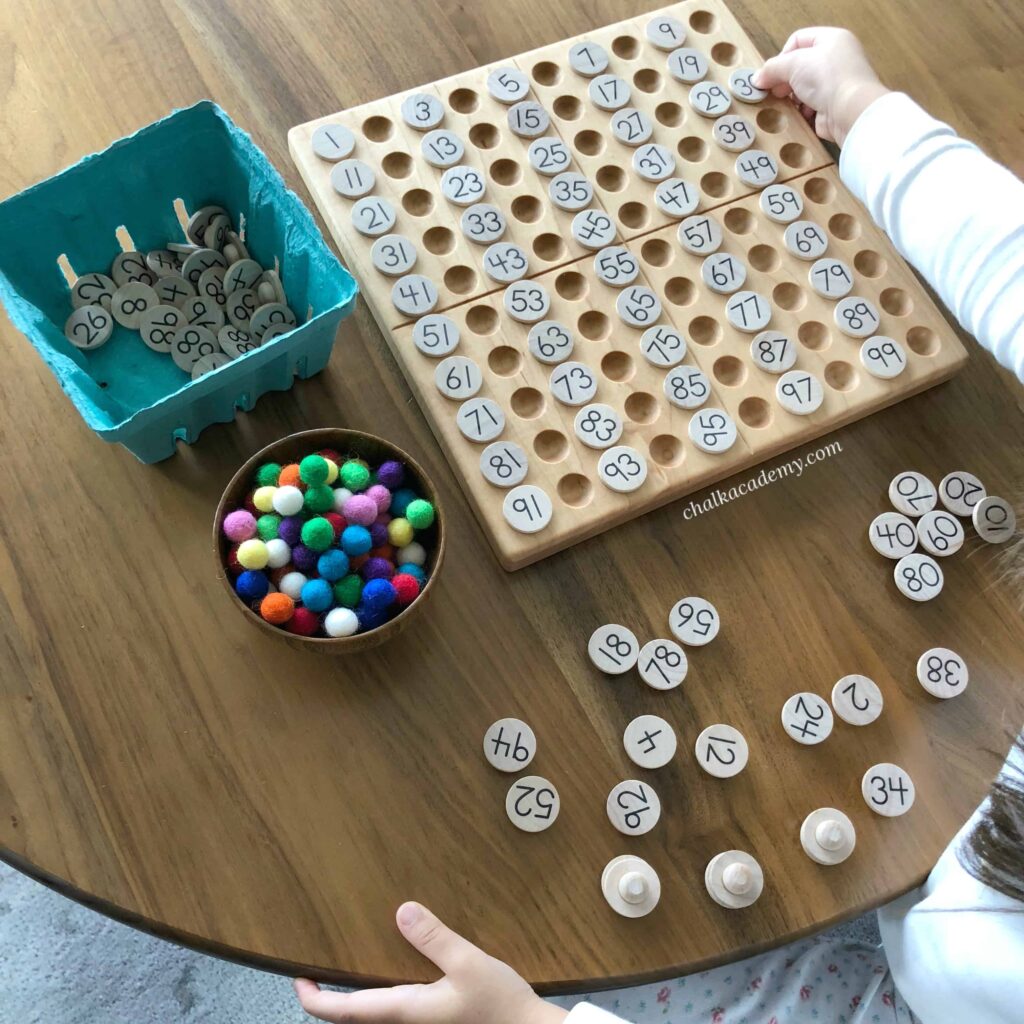
The number coins are a necessary add-on, and they are great for teaching number sequencing.
If your child has trouble finding the correct number, you can group the coins by 10s so the desired number is easier to find.
Learn even and odd numbers with a hundred board

With the pom-poms and number coins, you can demonstrate how even and odd number patterns work.
Learn how to skip count with a hundred board
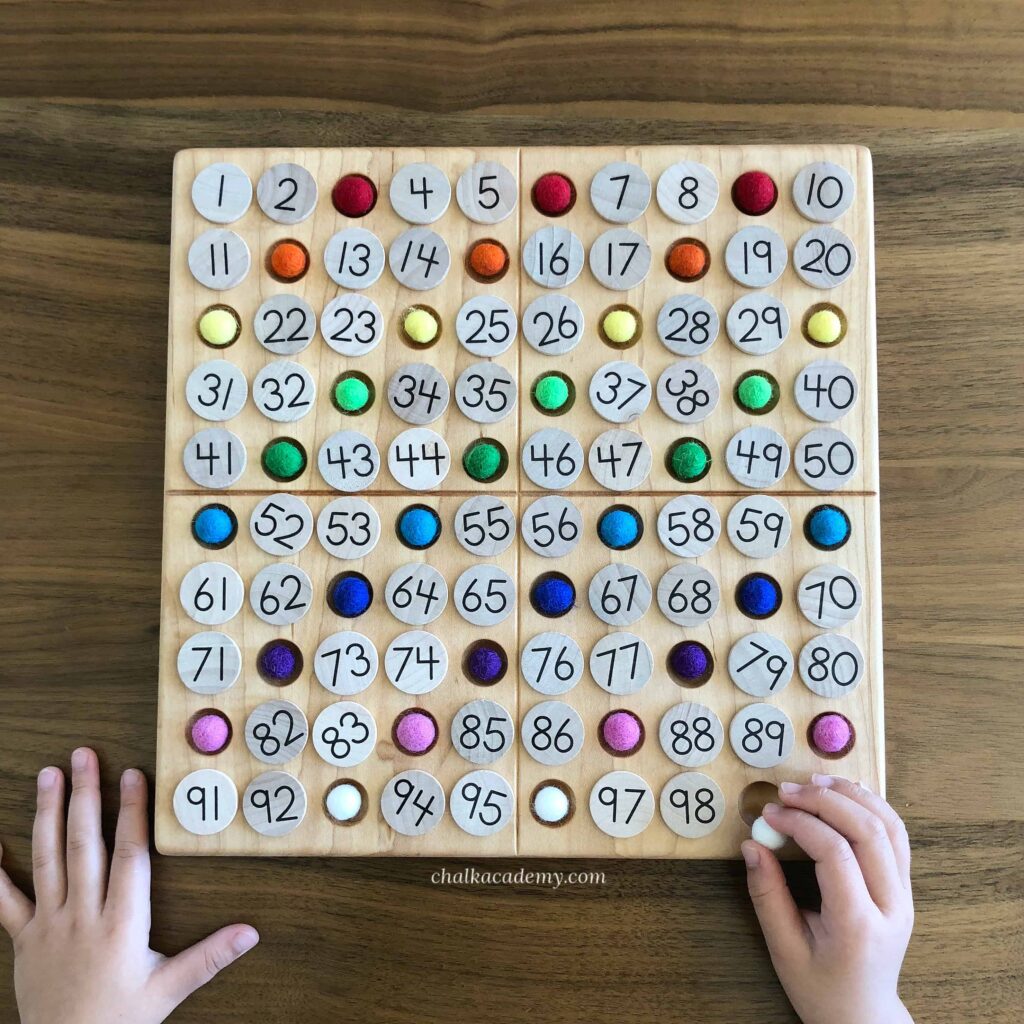
Here’s an example of skip counting by 3s! As a control, my daughter uses our printable hundred chart for reference to check her skip counting work independently.
Practice addition or subtraction with a dice game!
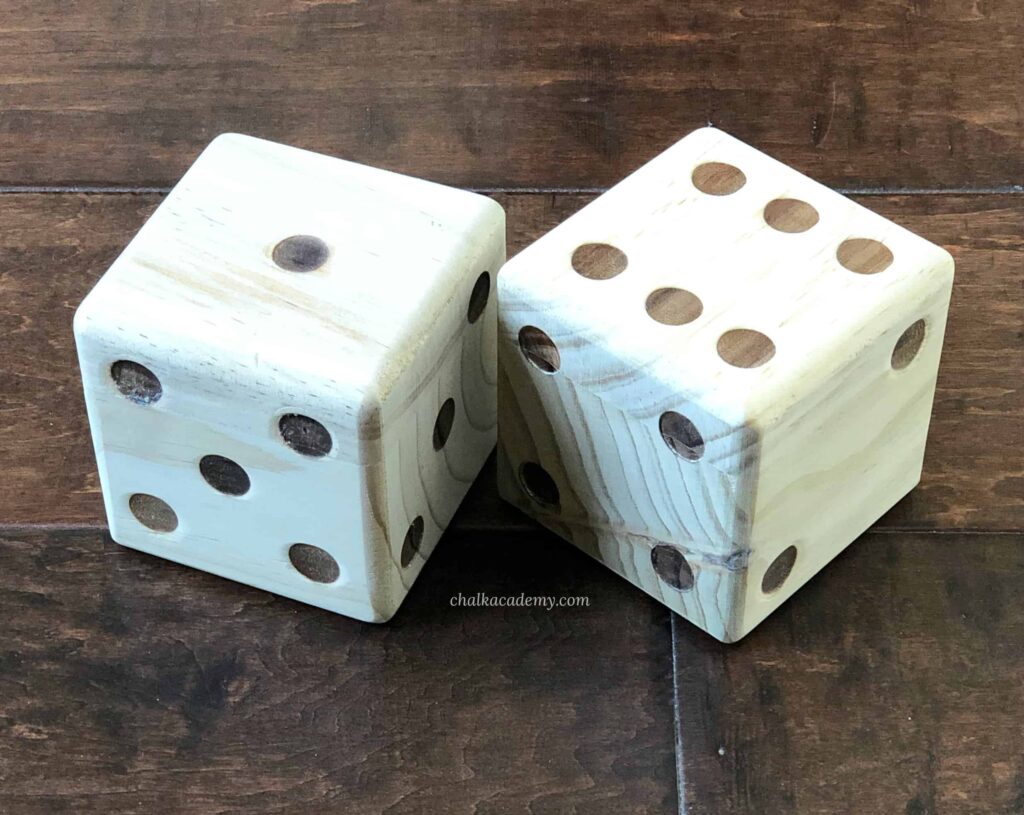
Dice games are a really fun way to practice math! Starting with an empty board, roll a dice, and add that quantity of balls. Then roll again and add that many. Continue until the board is full.
Alternatively, start with a full board, roll a dice, and subtract that number of balls. Then roll again and add that many balls. Continue until the board is empty.
We love this large wood dice set, and we also like these blank DIY wood dice as shown in this Chinese wood radical characters activity!
Strengthen fine motor skills with play dough
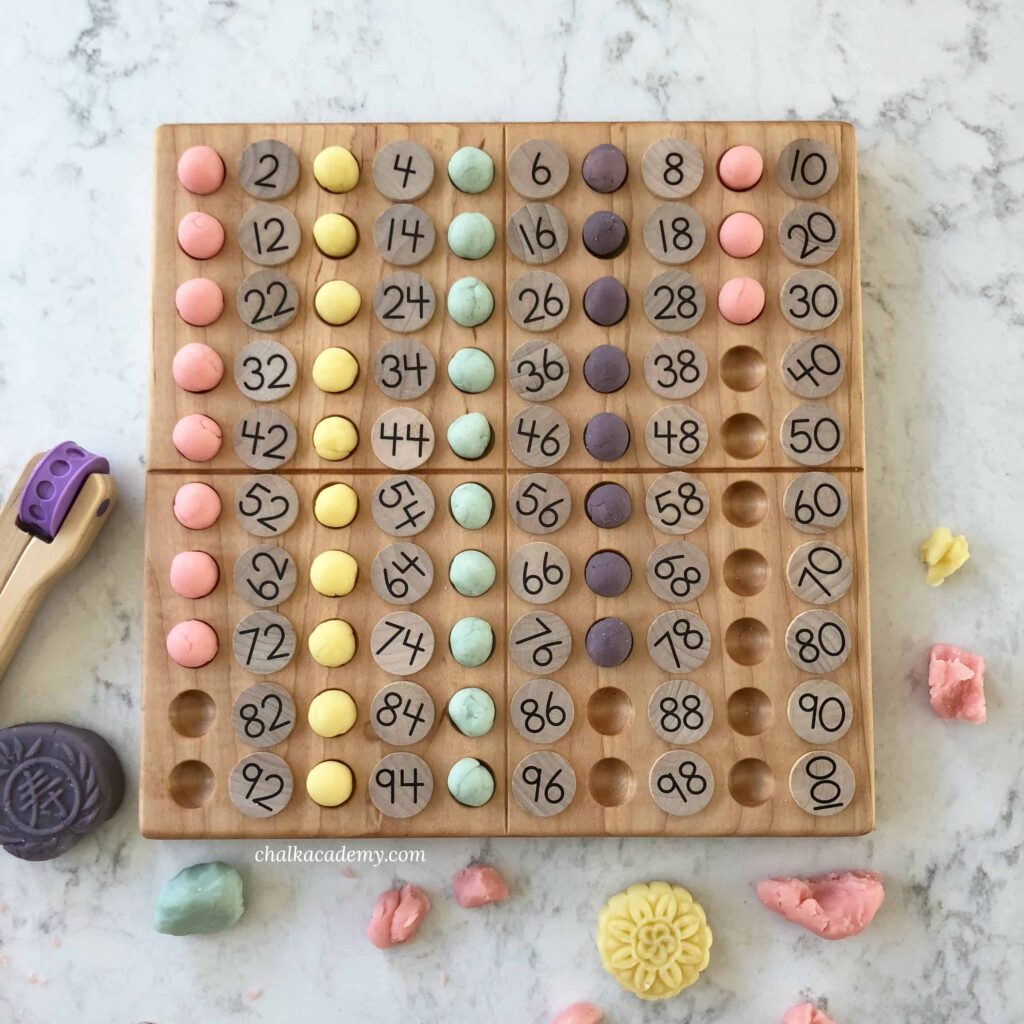
Most children love to mold different shapes with play dough, and I love seeing my kids get creative, like pretending to make little mochi balls! We have rolled so many together and are now experts in making them smooth and similar in size!
Practice multiplication
Since Treasures from Jennifer accepts requests for customization, you can request the number coins for the multiplication table!
Before getting this versatile 100 board, I bought the red Montessori Pythogoras Multiplication Board. In hindsight, I probably did not need both boards. Having one board with different number coin sets would have been a great way to save space and money.
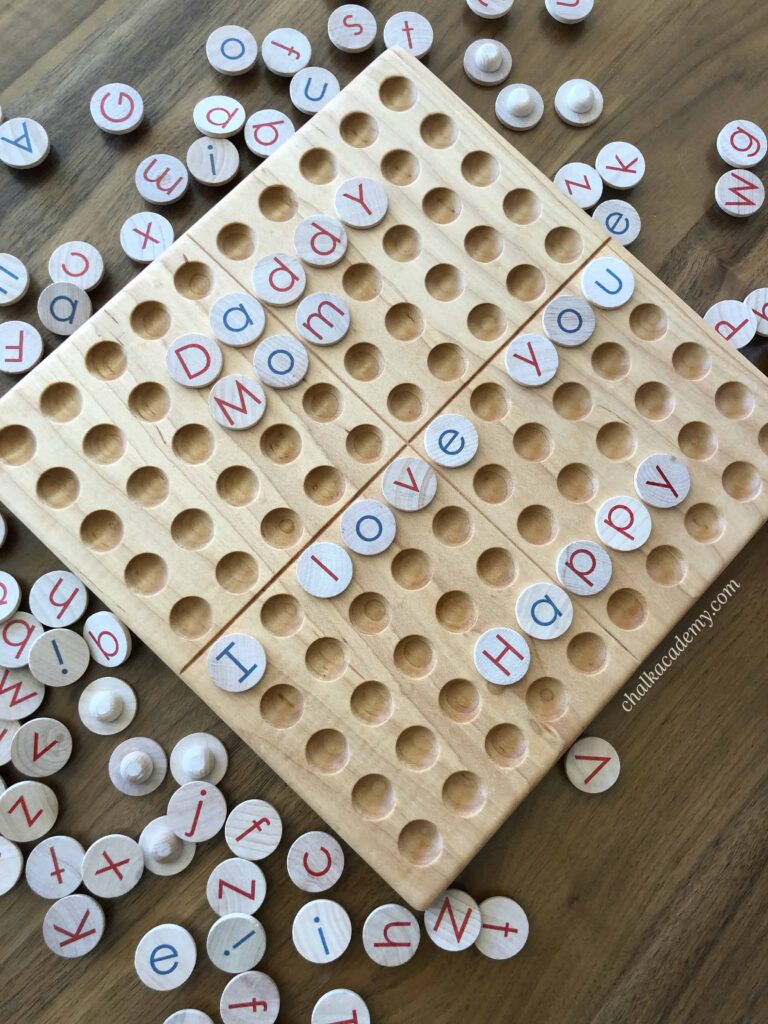
Build words with letters
English alphabet coins can be for reading and spelling practice. Following the Montessori colors, red is for consonants and blue is for vowels. Since my daughter previously tended to skip the vowel when she’d sound out words to spell, the blue color is a helpful reminder.
Treasures from Jennifer also take language requests! You can use this as a useful tool for teaching a second language, especially one with accented letters and characters. But to be honest, while my children have used our number coins countless times, they have rarely used our alphabet coins.
After your child has mastered the practices above in their native language, you can use the beginning exercises above to keep counting in a minority language. This can either be done verbally or by ordering custom coins from Treasures from Jennifer.
Teach geographic coordinates
You can use the engraved lines to represent latitude (north-south) and longitude (east-west) coordinates of a map! For example, you can put a pom pom at the coordinate that is 4 degrees west and 7 degrees south from the center.
Introduce graphing concepts
When kids get older, you can use the hundreds board to help visualize graphs. The engraved lines can also represent the X and Y-axis of a graph, and you can teach positive and negative numbers by designating the middle point as 0.
For example, you can look for -5 on the X-axis by moving five dimples to the left of the center. Rather than constantly having to draw out a graph, this allows you to easily move and adjust the numbers for lots of practice.
A budget-friendly hundreds board option
If you aren’t sure your child will actually use the hundreds board before you purchase it, you can try using a paper hundred chart first.
Just like with a hundred board, kids can learn how to count, add, subtract, multiply, and recognize patterns using the hundred chart. You can see all the ways I use a number chart here.
Because I’m always looking for opportunities to turn situations into a dual learning experience, I made a chart in English (Arabic numerals), Chinese numerals, and Korean numbers. With the template, you can print numerous copies and editions for practicing and coloring.
Once your child shows love for or engagement with the chart, I highly recommend picking up a wooden hundreds board. For both of my kids, it was well worth the investment to see them having so much fun practicing their math skills.
What do you think of the hundred board?
Do you have other teaching ideas? We would love to learn from you! Please leave a comment below!
This is such a helpful post, thank you! I’m wondering where you bought the rocks that were used for counting on the hundreds board?
Hi Elizabeth, Thanks for reaching out! We bought our mini rocks from a small shop that used to be on Etsy, but this set from National Geographic seems similar.
Hi Betty! This is a great post. Thank you! I see you bought the coins with pegs. Jennifer also has a no-peg version. I’d guess the no-peg version might be more versatile, as the coins lay flat…but I wonder if they slip/slide around the board (given there’s no peg)? Just curious about your child’s experience with the pegged coins. I’d love your thoughts! Thank you, Marisa
Thank your asking this question Marisa! I was wondering the exact same thing. Did you ever receive a reply, or did you buy a set- and if so what was your experience?
Hi Marisa and Rachel! Great question, and sorry for just seeing it now. Jennifer released the flat, pegless coins after we had purchased ours. I just got a chance to compare our version with our friend who has the newer version with the flat coins, and I think the flat coins are more user friendly for young children because they don’t move around so much. Also, if you’re bilingual, you could put translations on the other side of the coin. You would to need to get this hundred board with coin pockets though. I hope this helps with your decision!
Great education toy/tool. Where can I purchase it?
Hi Lily! Shopping information is in the “Where to Buy” section of the post. Please re-read the post to find that section. Thank you!